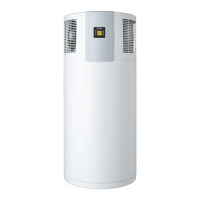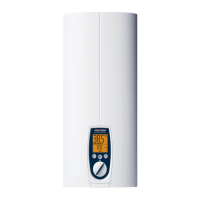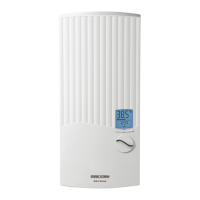OPERATION
MAINTENANCE AND CLEANING
10 |ACCELERA 300/WHP 300 WWW.STIEBEL-ELTRON.COM
Draft
12. Maintenance and cleaning
!
Please note:
Before any work on the equipment, disconnect all poles
from the mains.
12.1 Protective anode
An anode for the protection of the DHW cylinder is inserted right
in the center of the heat pump cylinder. Replace the anode with
a new one if the installed one has been consumed. When instal-
ling the anode, ensure that the metallic conductor connection is
correctly made. It’s recommended for first anode inspection to
happen after 2 years after installation. Your contractor, who will
be familiar with your waterquality, will advise you of the optimum
timing for inspection thereafter. Should it be impossible to insert a
rod anode (part no. 278235) from above, you may have a sectional
anode installed instead.
12.2 Cleaning the evaporator
Maintaining the full output of the appliance requires an occasional
professional cleaning of the evaporator. Clean the evaporator only
with water and a brush. Never use acidic or alkaline cleaning
solutions.
12.3 Draining the cylinder
» Close the shut-off valve in the cold water supply.
» Fully open the hot taps at all draw-off points.
» The cylinder is drained via the cold water inlet line. Residual
water remains in the lower part of the cylinder.
Note:
Hot water can be expelled during draining.
12.4 Cleaning and descaling the cylinder
» Remove the electric booster heater.
» Clean the cylinder through the inspection aperture. Use a des-
caling pump to descale the cylinder. Connect the pump between
the cold water connection and the inspection aperture. Ensure
that the protective anode is removed prior to descaling.
12.5 Safety valve (on-site)
This valve opens when the water pressure exceeds the preset value
of 7,5bar thereby relieving the pressure. It is adjusted so that no
water will be expelled when heating is switched OFF. Should it
continue to drip excessively, either the valve seat has become con-
taminated, the water pressure is too high or the pressure reducing
valve has become faulty.
12.6 Pressure reducing valve (on-site provision)
» Check the valve for perfect function. Replace it, if required.
12.7 Regular valve maintenance
Safety requires that valves are regularly checked for perfect func-
tion.
» Regularly vent the safety valve until a full stream of water flows
from it. Close the safety valve after checking.
How quickly limescale builds up depends on the local water
quality.
As your local contractor is familiar with your local water quality,
let him determine the timing of this check.

